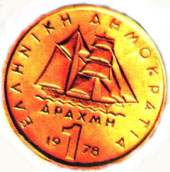DRACHMA Money in modern Greece |
 |
DRACHMA Money in modern Greece |
 |
During the Greek revolution and until 1828, the financial dealings were made with different foreign coins: English, French and mostly Turkish. The first Greek coins were mint at 1828 although the monetize has been decided very earlier, at 1822. The monetary unit was phoenix, silver coin consisting of silver (90%) and brass (10%). Coppery coins circulated also during the period 1828-1832. At 1932, after the great financial crisis which has begun at 1929, golden and silver coins were abandoned and obligatory bank note circulation was introduced.
The issue of bank notes has begun earlier, at 1885, when the Greek government authorized National bank, Ionian bank and Thessaly bank to issue bank notes of 2 and 1 drachma in a total amount of 18 million drachmas. At 1927 Bank of Greece was instituted, and obtains the exclusive authority of bank note edition. At this time the relation between drachma and english pound was 375 Drs = 1 pound.
During the World War II the destruction of capital and the reduction of the production leads to an enormous inflation and to the nullification of drachma. This has also effects on the relation between drachma and pound.
|
|
During November of 1944 new drachma is introduced, which in relation to the old one (the inflationary) is 1 to 50.000.000.000. Due to the bad financial conditions and to the political instability the inflation continues but with a much lower rate. The inflation ends at 1953, and the parity of drachma to the American dollar is determined 1 dollar = 30 drachmas. The parity was maintained with some ups and downs until 1973, when a new slow deflation started because of an inflation which begun at the same period. At 1983 the parity of drachma is 1 dollar = 85 drachmas, at 1993 1 dollar = 250 drachmas and at 1998 1 dollar = 305 drachmas
| Copyright ©1998, Stelios Tziras. |
| All rights reserved. Do not duplicate or redistribute in any form. |